|
|
|
Sort Order |
|
|
|
Items / Page
|
|
|
|
|
|
|
| Srl | Item |
| 1 |
ID:
129967
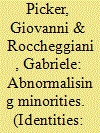

|
|
|
|
|
| Publication |
2014.
|
| Summary/Abstract |
This article expands the research on abnormalisation and the construction of social deviance of minorities. It focuses on the relationships between state practices, policies and expert knowledge addressing the Roma in Italy; it does so by first contextualising recent ethnographic findings on Turin authorities' social inclusion practices addressing Roma within the history of national and regional policies for Roma; it then contextualises those policies within the history of expert knowledge about Roma. Unlike what other studies on abnormalisation suggest, we argue that the abnormalisation of Roma in Italy is not primarily predicated upon the idea that they are at present unfit to follow the norms of the majority; rather, it stays upon a historically rooted representation of Roma oscillating between the poles of potential re-educability and potential dangerousness. In the conclusion we encourage further comparative research on abnormalisation, especially including practices and knowledge addressing other European minorities such as the Jews.
|
|
|
|
|
|
|
|
|
|
|
|
|
|
|
|
| 2 |
ID:
157082
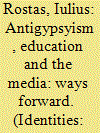

|
|
|
|
|
| Summary/Abstract |
This article is a self-reflection of my work over a decade of challenging school segregation of Roma across Europe. I look at how segregation has been framed and how communication around equality in education with the public took place. The education system is an important pillar in producing and reproducing antigypsyism in society. I see school segregation as an important mechanism that perpetuates antigypsyism. I explore ways to attract support for equality measures in education. One important strategy is to engage with media in transmitting messages to an audience that was usually not the target of inclusive discourses that promote diversity and equality as societal values.
|
|
|
|
|
|
|
|
|
|
|
|
|
|
|
|
| 3 |
ID:
084694
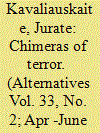

|
|
|
| 4 |
ID:
157075
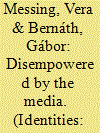

|
|
|
|
|
| Summary/Abstract |
Roma communities have experienced widespread historical exclusion in most European countries. The media can be a powerful instrument of a group’s inclusion into the mental map of a society, or, on the contrary, it can contribute to the group’s exclusion and disempowerment. This article builds on a series of content and discursive analyses of the news media’s coverage of Hungarian Roma communities since 1993, interviews with stakeholders and focus group discussions in Roma communities. It scrutinises media reporting about Roma and argues that, in general, the scope and the agenda of Roma’s portrayal coincide with mainstream society’s stereotypes about the group. The article will additionally look at the media’s disempowering role from two perspectives: on the one hand, the extent to which Roma have access to influencing media content, and on the other hand, it will consider the role of minority communities in challenging stereotypical images.
|
|
|
|
|
|
|
|
|
|
|
|
|
|
|
|
| 5 |
ID:
185637
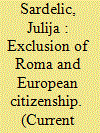

|
|
|
|
|
| Summary/Abstract |
Some 10-15 million members of the Roma minority live in Europe; an estimated 6 million are citizens of the European Union. It was not until the 1990s that European Union institutions began treating Roma as an ethnic minority deserving of human rights protections. Concerns about mass migration of Roma from Eastern European countries where they face severe discrimination was one of the reasons the EU included protections for Roma among the conditions that candidate countries had to meet to qualify for consideration in its most recent rounds of enlargement. Those EU efforts have overlooked similar discrimination and neglect in western member states.
|
|
|
|
|
|
|
|
|
|
|
|
|
|
|
|
| 6 |
ID:
112754
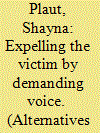

|
|
|
|
|
| Publication |
2012.
|
| Summary/Abstract |
This article traces how Roma are crafting and changing their representation in the media and thus discursively moving from passive victims to active subjects by engaging in strategic framing and advocacy. I focus on public discussions of the French expulsion of Roma in the summer of 2010. The nature of the coverage and the engagement of Romani voices mark a shift away from the traditional trope of Roma as criminal, victim, or absent. This is part of a shifting process where Roma use media as a political tactic, even to mobilize transnationally as a subaltern counterpublic. This article demonstrates how the tactic of counterframing is employed within Romani and mainstream English-language media and how Roma engage in media activist strategies to shift the frame away from demands for Roma to prove their worth as humans to the need for members of the European Union to prove they are not engaged in systemic economic, political, and social human rights abuses.
|
|
|
|
|
|
|
|
|
|
|
|
|
|
|
|
| 7 |
ID:
141465
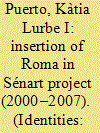

|
|
|
|
|
| Summary/Abstract |
Between 2000 and 2007, 34 Romanian families living in shanty towns in a Parisian suburb participated in a local group-specific social integration project. A socio-anthropological study was undertaken 2 years after it ended, including documentary analysis of its archives, interviews with its beneficiaries and the professionals involved and ethnography among three families with distinct integration histories. Using the analysis of the project’s implementation and outcomes, this article sheds light on how exceptional acts of minority identity recognition – sporadic and on a case-by-case basis – were ultimately functional in the performance of a republican redistributive policy on individual access to rights and resources based on the denial of racialised inequalities.
|
|
|
|
|
|
|
|
|
|
|
|
|
|
|
|
| 8 |
ID:
156235
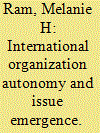

|
|
|
|
|
| Summary/Abstract |
How do international organizations (IOs) decide to address new issues? Most IO literature focuses on why states delegate to IOs and if, when, and how IOs are able to act autonomously. Less attention is paid to how IOs may use their autonomy to bring attention to new issues. This article theorizes about IO issue emergence using a qualitative case study of the advent of the World Bank's Roma inclusion agenda. By examining a case of issue emergence that appears to diverge from state demands, we can better understand how IOs exercise their autonomy and consequently shape global policy agendas.
|
|
|
|
|
|
|
|
|
|
|
|
|
|
|
|
| 9 |
ID:
169045
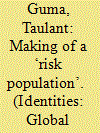

|
|
|
|
|
| Summary/Abstract |
This paper critically examines the processes of categorisation of Roma migrants in Glasgow, contributing to debates on the (unsuccessful) attempts of the EU and individual European states to tackle the social exclusion of various Roma populations living in Europe. Hitherto little attention has been paid to how measures aimed at improving the lives of Roma actually ‘work’ in practice, especially in the context of more recent Roma migration within Europe. Moreover, the role that ethnicity plays ‘on the ground’ has often been overlooked or taken for granted in the relevant literature. Based on 12 months of ethnographic fieldwork with Czech- and Slovak-speaking migrants, including Roma, in Glasgow in 2012, this paper aims to address this gap in the literature. Adopting a boundary-making perspective on ethnicity to analyse interactions in institutionalised settings, it traces and discusses various practices through which ‘the Roma’ were constructed as ‘a risk population’ in the city.
|
|
|
|
|
|
|
|
|
|
|
|
|
|
|
|
| 10 |
ID:
157078
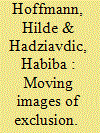

|
|
|
|
|
| Summary/Abstract |
This paper analyses the most prominent tropes in the earliest and most recent filmic representations of Roma. Stereotypical images of Roma abound in many fictional features as well as documentaries, from the representation of Roma as eternal nomads to racially prejudiced depictions of Roma women and the alleged innateness of music to Roma. Because images and modes of representation change over time, the paper juxtaposes the earliest portrayals of Roma with those produced in the last 15 years. The analysis particularly centres on two dominant reoccurring tropes: types of spaces typically occupied by Roma in film, that is the lack of a place or so-called placeless-ness of Roma; the gendered other, or the Roma woman and the culturally and ethnically othered Roma musician. Ultimately, by analysing how these tropes have persisted in varying forms over 100 years, this work points to the filmic imagery that perpetuates antiziganism, but also how the same has changed over the years to offer possible counter-narratives.
|
|
|
|
|
|
|
|
|
|
|
|
|
|
|
|
| 11 |
ID:
113870
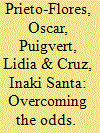

|
|
|
|
|
| Publication |
2012.
|
| Summary/Abstract |
How are different ethnic groups dealing with upward social mobility and assimilation? This is a large question that social research has tried to address in recent decades. In the United States, this issue has been framed by the theory of segmented assimilation. In Europe, regarding the Romà, the assumption still exists that upward mobility paths are intrinsically associated with a loss of ethnic identity, due to a process of full acculturation to the mainstream. In this article, through an analysis of 48 in-depth interviews with middle-class Romà in Spain, we identify other mobility paths, such as selective acculturation, that exist in addition to full acculturation. In this sense, we observe how symbolic differences exist between those middle-class Romà who live in an ethnic enclave and have a strong network of support and those who do not. In most cases, middle-class Romà tend to live outside the enclave and experience what we have called constricted ethnicity.
|
|
|
|
|
|
|
|
|
|
|
|
|
|
|
|
| 12 |
ID:
140879
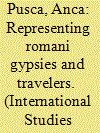

|
|
|
|
|
| Summary/Abstract |
Images of Romani Gypsies and Travelers abound in popular culture and the press, feeding into a series of stereotypes that appear to have survived largely unchanged for well over 200 years. With Romani and Traveler communities increasingly at the center of important debates on the treatment of migrants and ethnic minorities in Europe, these representations offer important insights into when and why Roma communities are sometimes conveniently visible or invisible, and how national and EU actors use their (in)visibility to make particular claims about solutions to discrimination. This article argues that although Roma and Traveler representations continue to follow traditional stereotypes, there is a noticeable change in their nature and the role that they play in both Roma and non-Roma communities. By juxtaposing iconic photographic representations of Gypsies by Josef Koudelka in 1960s Czechoslovakia and the rise of new reality TV series such as My Big Fat Gypsy Wedding and American Gypsies, this article aims to show the nature of change in Romani and Traveler representations and how they perform their collective identities.
|
|
|
|
|
|
|
|
|
|
|
|
|
|
|
|
| 13 |
ID:
157077
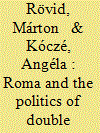

|
|
|
|
|
| Summary/Abstract |
The article analyses the politics of ‘double discourse’ in relation to Roma that has evolved in contemporary neoliberal Europe. On the one hand, the double discourse promotes the integration, rights and equal opportunities of Roma, on the other, it denies recognition of, and ways to address, enduring structural violence and rising social insecurity. The article argues that the politics of ‘double discourse’, as a neoliberal approach towards Roma, is structured by two contradictory discourses that speak to different audiences, using duplicitous approaches to create anti-Roma consensus and maintain the critical difference and subordinated position of the racialised Romani populations in Europe. By studying the representation of Roma in the cases of so-called 'child theft' in Greece and Ireland, and in the recent ‘refugee crisis’, the paper identifies and discusses three dimensions of contemporary neoliberal double discourse: racialised de-Europeanisation, neoliberal undeservingness and (dis)articulation of citizenship.
|
|
|
|
|
|
|
|
|
|
|
|
|
|
|
|
| 14 |
ID:
157081
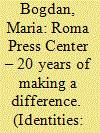

|
|
|
|
|
| Summary/Abstract |
The Roma Press Center (RPC) is the first Roma news agency in Hungary with the goal of reducing prejudice against the Roma. Their profile has been changed throughout the years, since the technological developments of the media and the political and economic changes of the country challenged their way of effectiveness. Until recently, the RPC was always about reacting to the negative stories about the Roma and balancing this image in the media. In the last 3 years, RPC changed its attitude by becoming a proactive media organisation which directly participates in shaping the public discourse about the Roma with their work. The interview with the two decisive characters of the RPC tells about this process.
|
|
|
|
|
|
|
|
|
|
|
|
|
|
|
|
| 15 |
ID:
157080
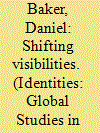

|
|
|
|
|
| Summary/Abstract |
This paper is a personal reflection by a Roma artist upon the mutual influence of Roma social relations and Roma visual culture. Strategies of art making are considered via analyses of contemporary Roma art works. It is suggested that historic marginalisation and continuing discrimination have determined the contingent nature of the Roma aesthetic resulting in keen facilities for adaptation and obscured visibility. Roma artefacts are shown to employ these resistant characteristics of Roma visuality to convey social, cultural, artistic and political agency via visual and performative means. The conclusion calls for a reconceptualisation of Roma visibilities so that we as Roma might forge new political unities and new forms of politics to more effectively challenge embedded Romaphobia.
|
|
|
|
|
|
|
|
|
|
|
|
|
|
|
|
| 16 |
ID:
157076
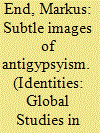

|
|
|
|
|
| Summary/Abstract |
This paper analyses the powerful stereotypical media discourse that shapes and reproduces a certain racialised and prejudiced perception of people identified as “Roma” in Germany. Using a close analysis of a single picture – appearing as harmless at first glance – and through the reconstruction of its various interpretational contexts and semantics the paper identifies mechanisms used in stereotypical media coverage of “Roma”. This qualitative analysis draws on media analysis of antigypsyism as well as on research of photographic construction of the “gypsy” in order to analyse the contemporary visual regime of “Roma” in Germany. As it portrays “the Roma” as a fundamentally different and socially deviant group, this visual stereotyping is shown to be an integral element of the persistent antigypsyist ideology, deeply embedded in German society.
|
|
|
|
|
|
|
|
|
|
|
|
|
|
|
|
| 17 |
ID:
157079


|
|
|
|
|
| Summary/Abstract |
The visual image of Roma people in the media is mired in racialised notions of ‘the other’. Whilst we know what Roma stereotypes look like, there is little clarity as to how a ‘non-stereotypical’ image might be constructed. In order to examine the non-stereotypical, two sources of images are analysed: (1) entrants from an anti-stereotype Roma photography competition and (2) self-representations produced by Roma participants during ethnographic research. The findings show that if ‘Roma’ is foregrounded as the subject, even a non-stereotypical approach can reproduce ‘difference’ (from a supposed ‘norm’). ‘Roma’ is thus, at the moment, still strongly linked to a notion of ethnicity that is seen as different and racialised. However, when ethnicity is not emphasised, but rather self-representations and the ‘everyday’, such orthodoxies are challenged. These sources provide a unique opportunity to create a deeper understanding of ‘non-stereotypical’ images in order to challenge misrepresentations and racism.
|
|
|
|
|
|
|
|
|
|
|
|
|
|
|
|
|
|
|
|
|